HDMS Tordenskjold (1880)
 Denmark Torpedo Ram built 1878-81, decomm. 1908
Denmark Torpedo Ram built 1878-81, decomm. 1908
Development of the sole Danish Torpedo Ram
HDMS Tordenskjold was not the largest, not most famous pre-WWI Danish warship, but it was the only one of its kind. It was designed in Copenhaguen back in 1878 as a Torpedo-Ram. This partially armored, heavily armed experiment was also unusual for other navies. It really fit no known type entirely but borrowed on many designs at once. It had the largest gun of all nordic fleets, was entirely steel-built and had all-electric lighting. She was also a torpedo carrier mothership. Launched in 1880, she served until 1908 in the Danish Navy.
It seems forgotten today, but Denmark had once the largest regional fleet, split between the Baltic and north sea. Before Germany was united in 1870, the small Prussian Navy was largery inferior, and for that reason in 1864, a short-lived, uneasy alliance was passed with Austria to bolster its strenght and ultimately won the Schleswig-Holstein war. At the time, Denmark had three broadside ironclads, a screw battleship, a turret monitor and six frigates. The country suffered much for this defeat but launched another naval program, with coastal armoured ships of many types: The turret ship Lindormen in 1868, Gorm in 1870, Odin in 1872, and Helgoland in 1878, but also the screw corvette St Thomas, and planning its first cuiser in 1880s, HDMS Fyen. In 1880 the Danish admiralty launched also a program of coastal defense based on torpedo ship of several types. There was a torpedo boat program (Five in the 1880s, plus seven 2nd class), but also a larger torpedo ship able also to lead these torpedo boats.
Seeing what existed in other admiralties, the all-metal, steam only torpedo ram of the late 1870s, an evolution of the American civil war experiments, seemed an interesting way to deter an enemy fleet. Invulnerable due to its armoured hull, low on water, powerful machinery to achieve the required speed, and a ram, these vessels were supposed to struck an enemy admiral ship and desorganize the incoming fleet. Another concept was just emerging also, the torpedo cruiser (later torpedo gunboat), basically the mediocre precessor of the destroyer. This ship had a light armament but was entirely dedicated to fire this new weapon developed in Austria-Hungary previously, the torpedo. Around these two ideas, the torpedo ram and torpedo cruiser, the Danes designed a very unusual ship, which remained one of its kind.
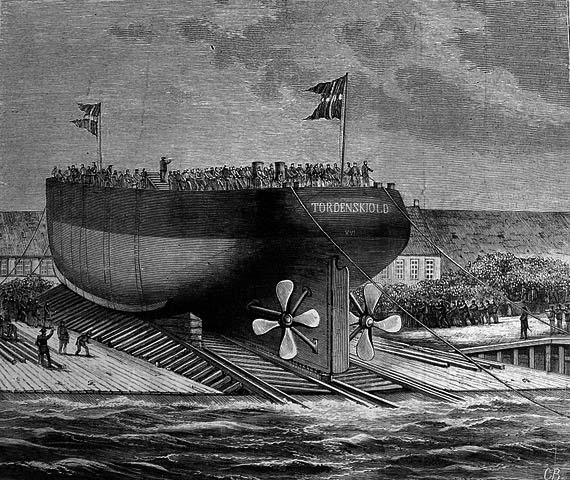
HDMS Tordenskjold was named for Vice Admiral Peter Tordenskjold, leading the Danish fleet in the 1716 Battle of Dynekilen, during the Great Northern War. The name could also be translated by “thunder shield”.
This Danish armored ship was, as Steensen writes, “a unique ship”. The navy board at first wanted an improved version of the previous HDMS Helgoland (armoured coast defense ship designed in 1875, launched 1878), and preliminary drawings were ready in 1877. In the appropriations for 1878-79 however, budget cuts meant she has to be sized down to an armored gunboat. The result was a kind of overgrown gunboat, half the size of HDMS Helgoland. She was built in Orlogsværftets Yard, Copenhaguen, laid down on 5.6.1879, launched 30.9.1880 and commissioned in 29.9.1882.
Design of HDMS Tordenskjold
Tordenskjold had not proper side armor but instead a vaulted armor deck plus a barbette around the main forward cannon. The later was even larger however than for Helgoland (which had a 12-in (305 mm) 22 caliber cannon). This 14-in (355 mm) 25 caliber was indeed the Danish Navy’s most powerful to date, largest cannon ever put on a warship at the time among the Nordic countries. By virtue of its 8.9 m barrel it was soon also nicknamed “Lange Tom”. Tordenskjold also innovated as being the Navy’s first ship all steel built warship, and the first with full electric lighting, allowing the elimination of portholes. She was intended to include two 2nd class torpedo boats (Nos. 4 and 5) onboard, manned by cranes, and be used as a “torpedo boat carrier”, in addition to four torpedo tubes, forging the Navy designation of a “Torpedo Ship”. In 1885 it was changed to an “armored ship” or “Panzerskepp”.
Hull and protection
This 2,462 tonnes standard vessel, with a steel frame and cover (no iron but for small parts), was relatively narrow at 13.21 (43 feets 5 in) for its lenght of 67.75 m (222 ft 3 in), compared to Helgoland notably (18 m or 60 feets). Its draught was one meter less also (4.80 or 15 ft 9in) compared to 5.90 m of Helgoland. However her overall appearance was also different, wich just the barbette gun forward as a change. She had a single mast instead of two, stuck in between two tall and narrow funnels, with a conning tower in front of the forward funnel and an open bridge above as usual for the time.
Her deck plan was peculiar also as she was taller aft rather than forward. He prow indeed was low over water, almost as a monitor, in order to present the minimal hull surface to the enemy when approaching for ramming or firing. The aft section which ran for about 2/3 of the overall lenght was about 1.80 m higher. Without a proper belt, she was protected by a 38mm (1.5 in) armored deck with 97mm slopes (3.8 in) (3-3/4in steel deck), probably with coal stored above and below it. The main gun was protected by a 203mm barbette (8 inches). The thickness of the armoured cover is unknown, probably around 20 mm to offer some protection against shrapnel.
Powerplant
HDMS Tordenskjold was propelled by two compound-expansion 2-cyl reciprocating steam engines, fed by 8 cylindrical Burmeister & Wains boilers, rated for a total of 2,600 ihp (1,900 kW). These drove two shafts. The ram achieved 13 knots (24 km/h; 15 mph) only, -a bit slow to ram another vessel. Her was also limited by the coal she carried, 170 tons, to 1,500 nmi (2,800 km; 1,700 mi), at 9 knots (17 km/h; 10 mph), allowng to reach the eastern baltic, the bay of biscaye or northern Norwegian waters.
Armament of HDMS Tordenskjold
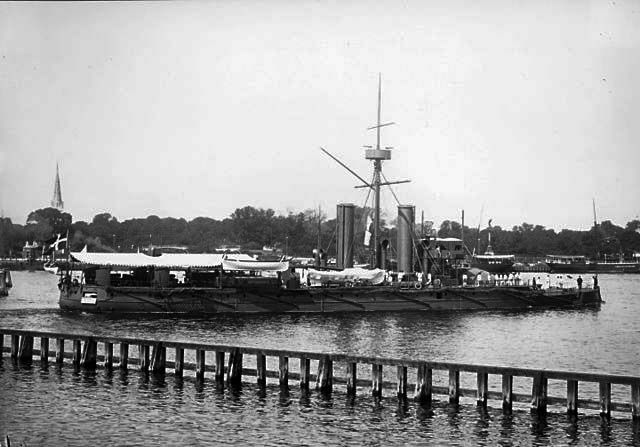
Tordenskjold in 1986
The centerpiece of this bold design was its very large (at least for nordic seas) 35 cm Krupp gun, or 15 inches. It was placed in the forward barbette but the latter was partially protected by an hemispheric armoured cover, with an opening for the gun. Both the gun mount and cover rested on rails below the barbette proper floor, inside the inner ring, one deck below. The reloading appartus was another deck below with an elevator and storage. However its rate of fire was absysmal, little less than ten minutes for each shot in the best circumstances. Useful range was just 9 km. The cannon’s rotation and hoisting of ammunition took place via hydraulics. The gun crew was reduced to 16 men versus 19 in Helgoland.
The secondary armament comprised four five-inch guns (120 mm) Krupp breech loaders placed on the aft deck, behind armoured shields. The four 12 cm cannons on the aft deck could fire every two minutes. They were originally unprotected, but in 1889 received steel shields. Their rate of fire was one shot every two minutes and they were originally unprotected. It’s only in 1889 the steel shields were installed.
They were placed on traversing rings and rails. The rest of the armament is more difficult to assess give the plans. These was seemingly a single thee inches muzzle loader which purpose was probably ceremonial (salute gun) but its position could not be asserteed. However the four 37 revolver guns were placed on the broadside decks, two abaft the conning tower and bridge, two at the foot of the main 60cm projector platforms on either side.
Lastly, HDMS Tordenskjold had three torpedo tubes: One was in the bow, centerline, and of 38 cm (15 inches), well visible on the plan underwater, below the ram, with the storage room behind for twelve torpedoes. The two stern torpedo tubes of the 35.5 caliber (13.9 in) were above water in what seems traversing mounts. The torpedo storage room was located well behind and one deck below. By 1883 she was converted to carry two small 2nd class Torpedo boats (N°4, 5) and carried them in two missions only, before as in other navies, the concept showed fundamentally flawed.
- 1 x 35 cm Gun
- 4 x 12 cm Guns
- 1 x 3″ Muzzle Loading Gun
- 4 x 37 mm Revolver Guns
- 1 x 38 cm Torpedo tubes (bow)
- 3 x 35,5 cm Torpedo tubes
- 2x 2nd class Torpedo boats (N°4, 5)
1883 upgrade: Barely after one year of service, she was rearmed with a single 84mm/13 gun muzzle loader instead of the 3-in, and four quintuple 37mm/17 M.1875 Nordenfelt guns.
1905 Rearmament:
- 2 x 37 mm Recoil Guns
- 6 x 37 mm Revolver Guns
- 8 x 8 mm Mitrailleuses (Machine guns)
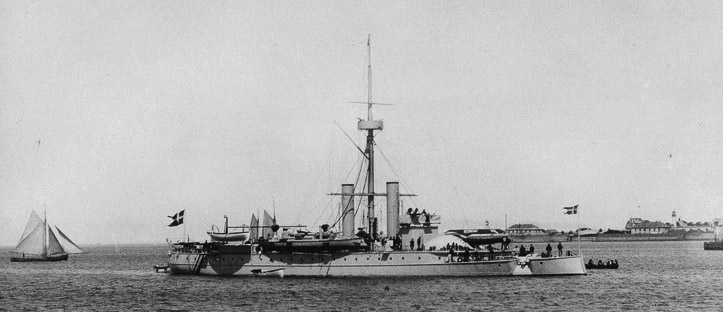
Tordenskjold in 1986
⚙ Specifications as built |
|
| Dimensions | Lenght 67,75 x 13.20 x 4.80 m |
| Displacement | 2,462 long tons standard |
| Crew | 220 |
| Propulsion | 2 screws, two compound steam engines, 8 boilers, 2,600 ihp (1,900 kW) |
| Speed | 13 knots (24 km/h; 15 mph) |
| Range | 1,500 nmi (6,960 km) at 10 kn (19 km/h; 12 mph) |
| Armament | 1x 14-in, 4x 5-in, 4x 3-pdr, 4 TTs, see notes. |
| Armor | Barbette 8 in, Deck: 3-4 in |
Active carrer
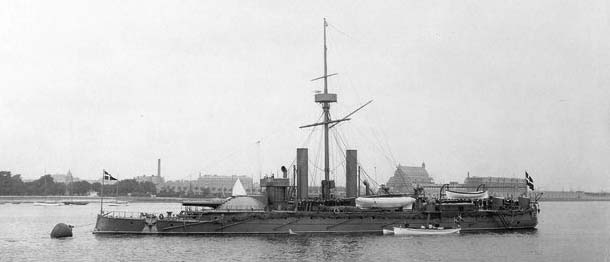
From her commission in 1882, HDMS Tordenskjold was regularly featured in annual squadrons parade, also featured for representative tasks, making official visits to Germany and Russia. Her powerful 35.5 cm cannon made desmonstrations with blank rounds to a mervelling audience, each time the whole ship shook. The two torpedo boats were on the voyages in 1883 and 1884, but from 1888 they were no longer attached to the ship. “Thundershield” made her last voyage in 1901. She was mothballed and partially disarmed as an accomodation and gynnery TS, then in 1908 she was discarded, written off, and sold, later scrapped in Germany.
Links
On worldnavalships.com
On www.navalhistory.dk
On navypedia
wiki (denmark)
Conway’s All the World’s Fighting Ships 1860-1905.
Balsved, Johnny E. “TORDENSKJOLD (1882-1908)”. Danish Naval History.
Silverstone, Paul H. (1984). Directory of the World’s Capital Ships. NYC


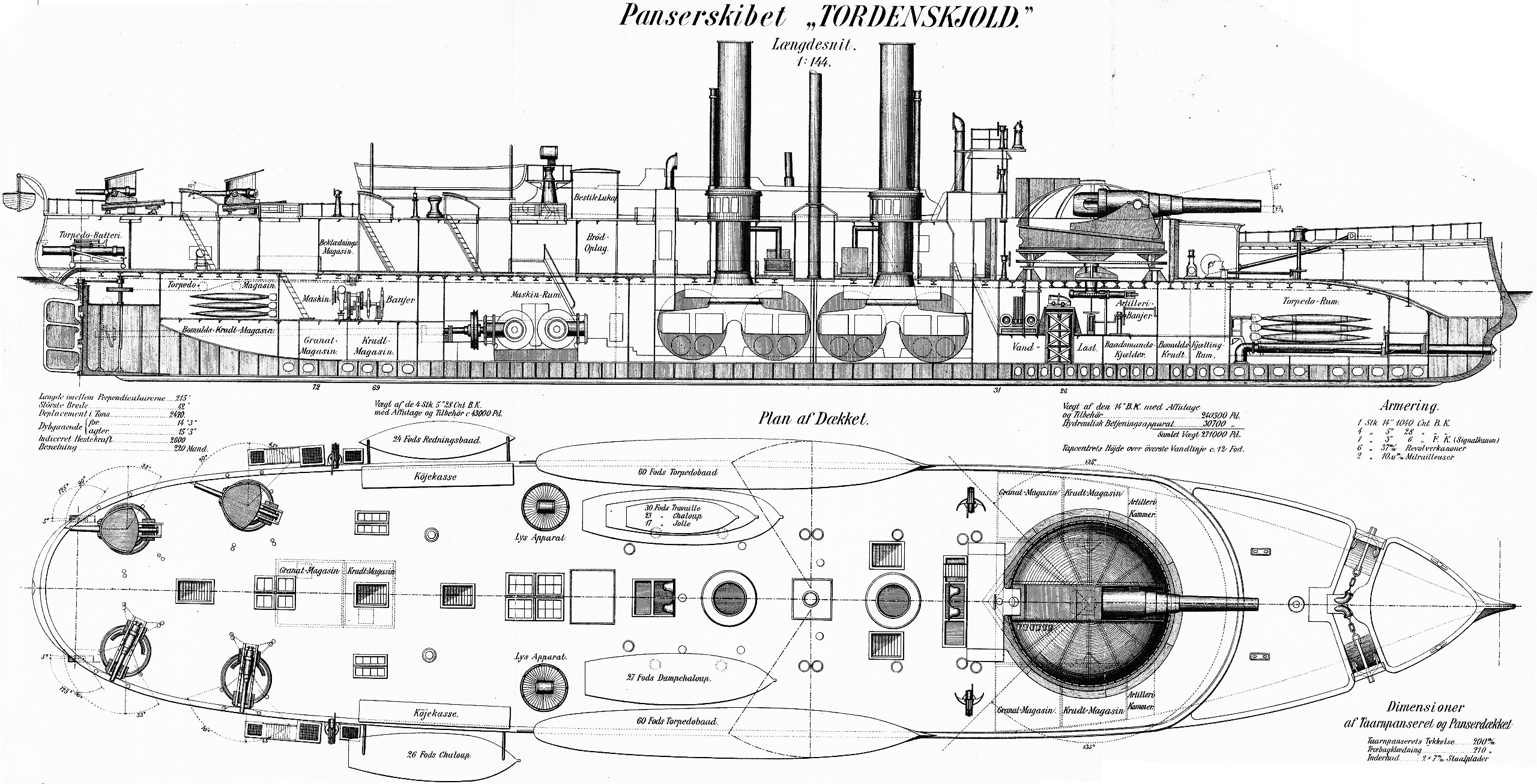
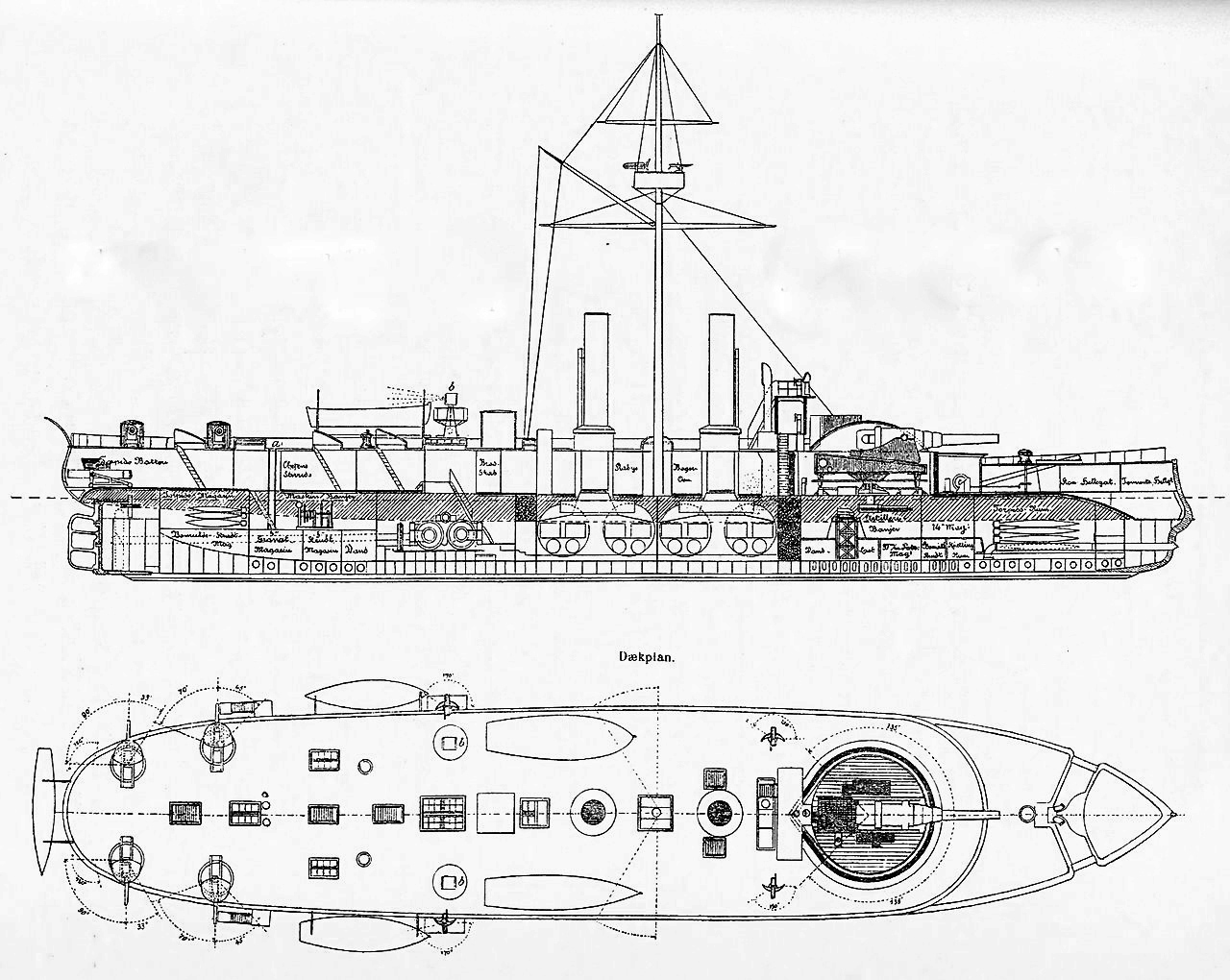
 Latest Facebook Entry -
Latest Facebook Entry -  X(Tweeter) Naval Encyclopedia's deck archive
X(Tweeter) Naval Encyclopedia's deck archive Instagram (@navalencyc)
Instagram (@navalencyc)





 French Navy
French Navy Royal Navy
Royal Navy Russian Navy
Russian Navy Armada Espanola
Armada Espanola Austrian Navy
Austrian Navy K.u.K. Kriegsmarine
K.u.K. Kriegsmarine Dansk Marine
Dansk Marine Nautiko Hellenon
Nautiko Hellenon Koninklije Marine 1870
Koninklije Marine 1870 Marinha do Brasil
Marinha do Brasil Osmanlı Donanması
Osmanlı Donanması Marina Do Peru
Marina Do Peru Marinha do Portugal
Marinha do Portugal Regia Marina 1870
Regia Marina 1870 Nihhon Kaigun 1870
Nihhon Kaigun 1870 Preußische Marine 1870
Preußische Marine 1870 Russkiy Flot 1870
Russkiy Flot 1870 Svenska marinen
Svenska marinen Søværnet
Søværnet Union Navy
Union Navy Confederate Navy
Confederate Navy Armada de Argentina
Armada de Argentina Imperial Chinese Navy
Imperial Chinese Navy Marinha do Portugal
Marinha do Portugal Mexico
Mexico Kaiserliche Marine
Kaiserliche Marine 1898 US Navy
1898 US Navy Sovietskiy Flot
Sovietskiy Flot Royal Canadian Navy
Royal Canadian Navy Royal Australian Navy
Royal Australian Navy RNZN Fleet
RNZN Fleet Chinese Navy 1937
Chinese Navy 1937 Kriegsmarine
Kriegsmarine Chilean Navy
Chilean Navy Danish Navy
Danish Navy Finnish Navy
Finnish Navy Hellenic Navy
Hellenic Navy Polish Navy
Polish Navy Romanian Navy
Romanian Navy Turkish Navy
Turkish Navy Royal Yugoslav Navy
Royal Yugoslav Navy Royal Thai Navy
Royal Thai Navy Minor Navies
Minor Navies Albania
Albania Austria
Austria Belgium
Belgium Columbia
Columbia Costa Rica
Costa Rica Cuba
Cuba Czechoslovakia
Czechoslovakia Dominican Republic
Dominican Republic Haiti
Haiti Hungary
Hungary Honduras
Honduras Estonia
Estonia Iceland
Iceland Eire
Eire Equador
Equador Iran
Iran Iraq
Iraq Latvia
Latvia Liberia
Liberia Lithuania
Lithuania Mandchukuo
Mandchukuo Morocco
Morocco Nicaragua
Nicaragua Persia
Persia San Salvador
San Salvador Sarawak
Sarawak Uruguay
Uruguay Venezuela
Venezuela Zanzibar
Zanzibar Warsaw Pact Navies
Warsaw Pact Navies Bulgaria
Bulgaria Hungary
Hungary

 Bundesmarine
Bundesmarine Dutch Navy
Dutch Navy Hellenic Navy
Hellenic Navy Marina Militare
Marina Militare Yugoslav Navy
Yugoslav Navy Chinese Navy
Chinese Navy Indian Navy
Indian Navy Indonesian Navy
Indonesian Navy JMSDF
JMSDF North Korean Navy
North Korean Navy Pakistani Navy
Pakistani Navy Philippines Navy
Philippines Navy ROKN
ROKN Rep. of Singapore Navy
Rep. of Singapore Navy Taiwanese Navy
Taiwanese Navy IDF Navy
IDF Navy Saudi Navy
Saudi Navy Royal New Zealand Navy
Royal New Zealand Navy Egyptian Navy
Egyptian Navy South African Navy
South African Navy






























 Ukrainian Navy
Ukrainian Navy dbodesign
dbodesign